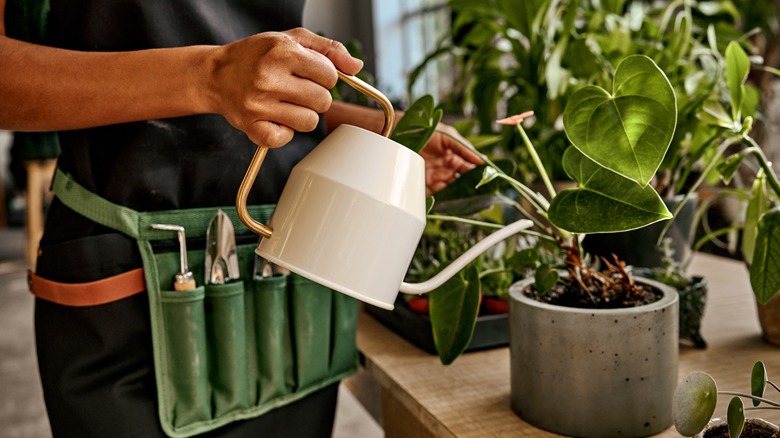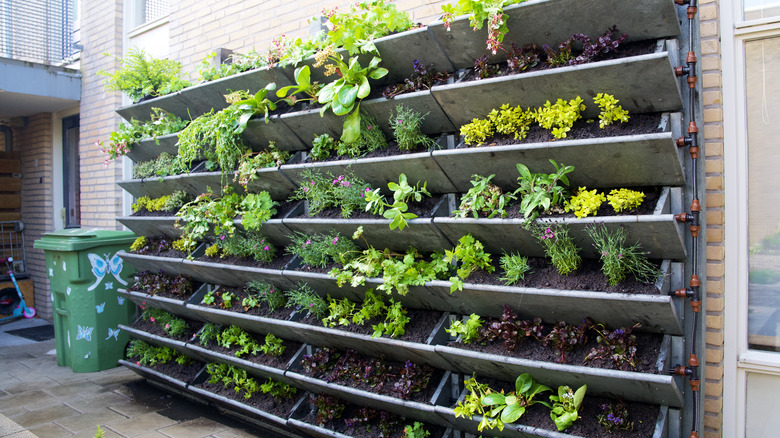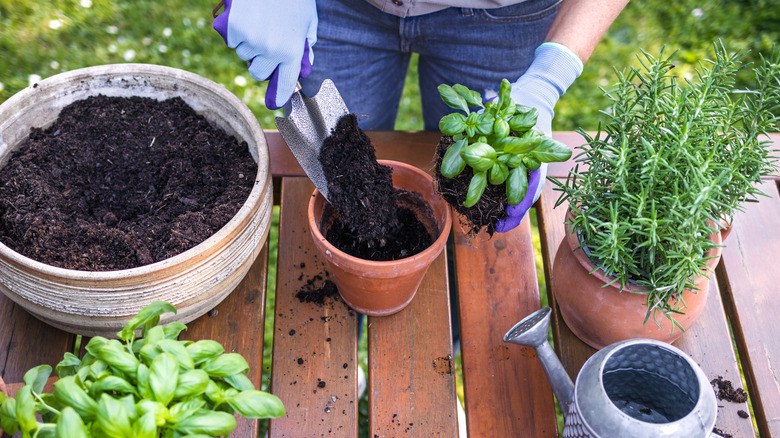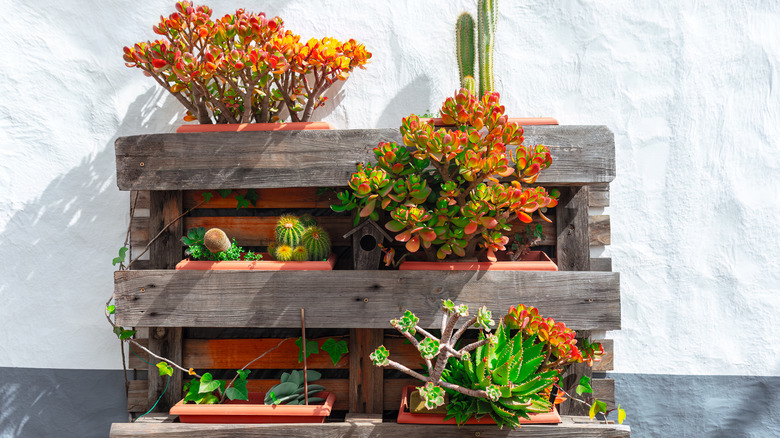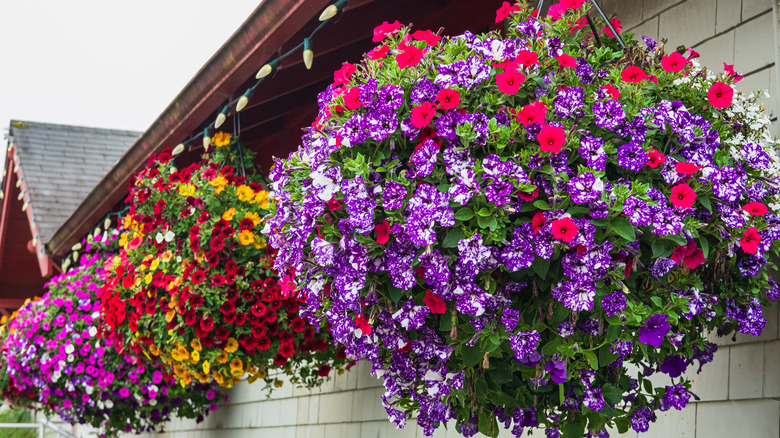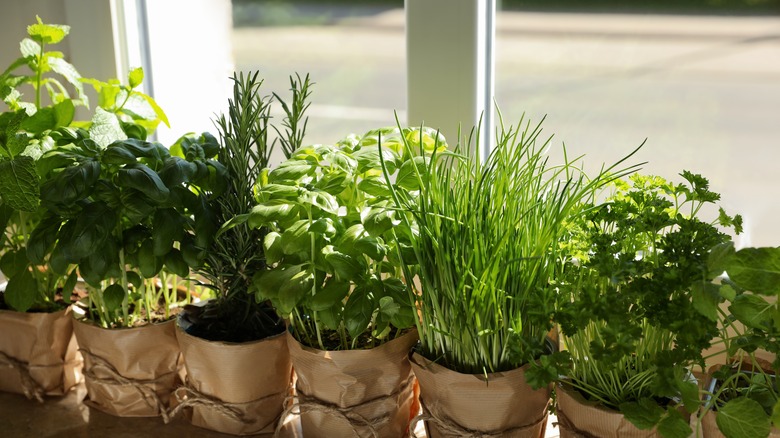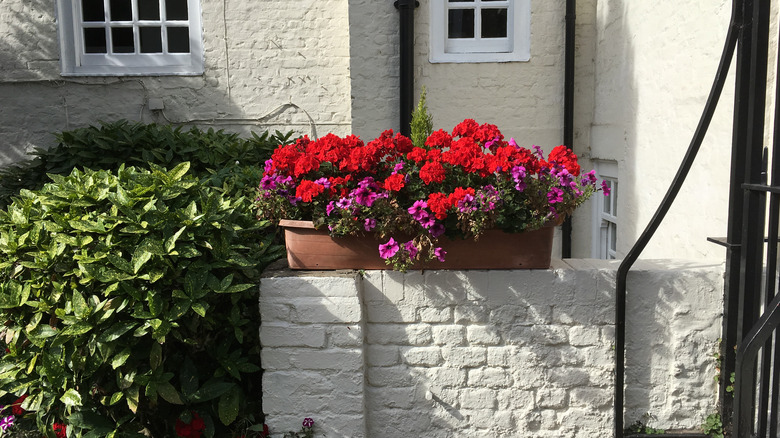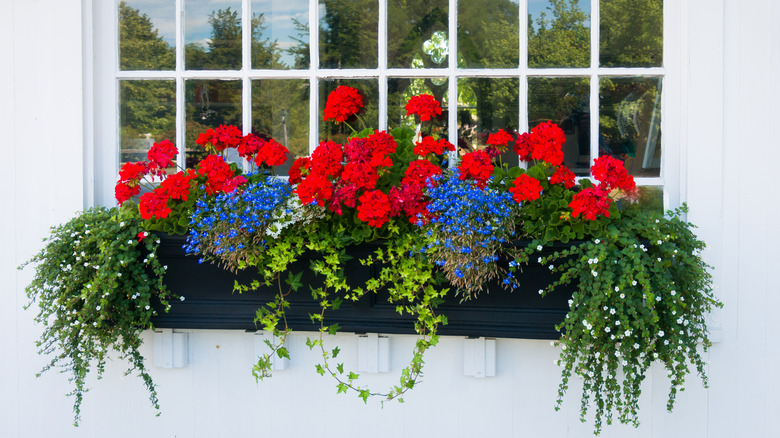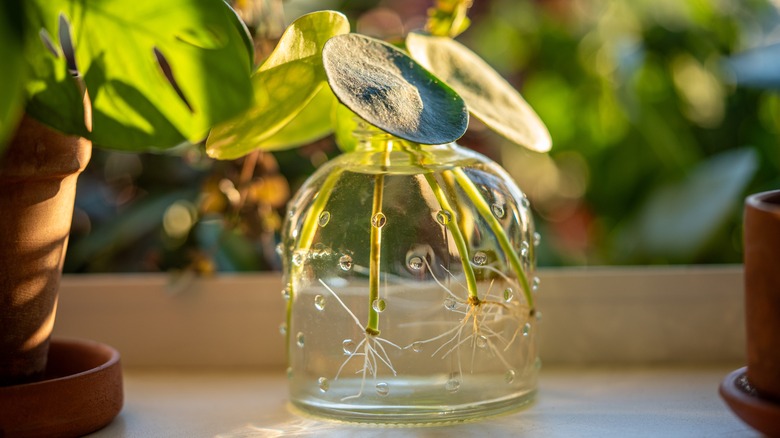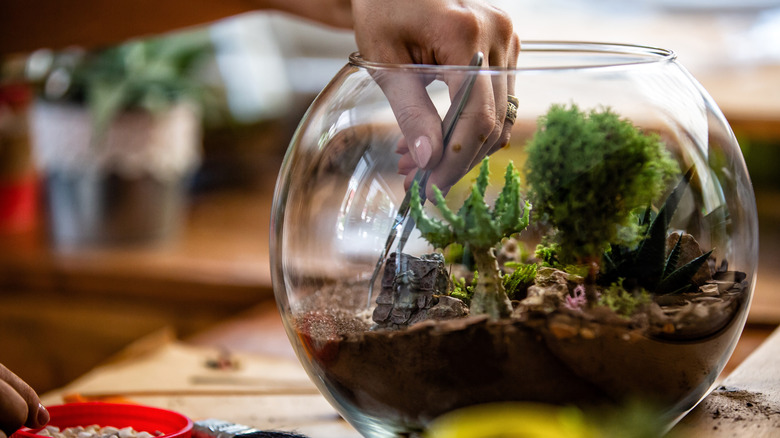10 Clever Gardening Hacks For Homes Without A Backyard
We may receive a commission on purchases made from links.
We all know that green spaces and gardens are great for the community and our environment, but they also provide benefits on a slightly more selfish level. Research from the Royal Horticultural Society indicates that people who garden daily have an increased sense of well-being and lower stress levels compared to people who don't garden. Gardening isn't only advantageous to mental health, but also physical health. Interestingly, figures from Harvard Medical School indicate that 30 minutes of gardening burns a similar level of calories to badminton, yoga, or gymnastics. Clearly, the arguments for gardening are strong, but if you don't have a backyard, your gardening opportunities may feel somewhat lacking.
Fortunately, there are plenty of gardening hacks for people with homes with compact outdoor spaces or no outside area at all. Options include installing hanging baskets on your balcony, fixing window boxes to the front of your home, or even joining a local community garden to get your horticultural fix. Gardening really is accessible to all — even those lacking a backyard — with these clever workarounds.
Utilize vertical space on a balcony or terrace
Most plants naturally grow vertically because they reach up towards the sun, but vertical gardening refers to the way plants can be supported or positioned to cover a vertical space like a wall. David Hillock, a consumer horticulturist at Oklahoma State University says, "Vertical gardening is a great way to take advantage of empty vertical space such as walls or fences, or even free-standing structures. This is a unique way to add visual interest. In addition, vertical gardening has potential benefits for senior citizens or those who may live in apartments with only a balcony for outside space or in a home with a small yard." If you lack a backyard you can create a vertical garden on any available walls or fences with access to sunlight.
Vertical gardening can take many forms, so you can customize this type of gardening to suit your circumstances. If you have a balcony or an external wall, you could use a hanging planter system like this one from Amazon to grow flowering annuals that will last all summer. These work well if you want to fit lots of plants into a small space, because they feature many deep pockets for soil. Alternatively, fix a trellis to your outside wall and grow climbers like clematis or honeysuckle for a pretty, low-maintenance option. Vertical gardening can even be achieved if you don't have any walls or fences available. Try out a freestanding vertical planter like this one from Target.
Grow a bounty of herbs and veggies in containers
Eager to try your hand at growing your own produce, but short on outdoor space? The solution could be container gardening. This works brilliantly for anyone who doesn't have a backyard because containers are portable, so once summer is over and you have collected your harvest, you can use the containers to grow houseplants indoors or easily store them until the following season. There are so many different items that can be repurposed as growing containers, making this a super budget-friendly option. Consider using an old ice cream tub or a bucket as your planter, selecting an object that works with the size of your outside space.
Some vegetables and herbs are better suited to container growing than others, so you'll need to learn about these if you want to produce a successful harvest. Michigan State University recommends that bell peppers and hot peppers do well in containers, along with tomato plants and eggplants. If herbs are more your thing, try parsley, sage, cilantro, or thyme. Mint plants do very well in containers, but they have a vigorous growth habit, so set them in their own pots to prevent them from taking over other herbs. You can grow mint plants from cuttings, which will cut down costs when starting a container garden.
Enjoy a compact garden space with the help of a plant shelf unit
A plant shelf unit, like this one from Target, will be a dream come true for any would-be gardeners who have been limited in their green-fingered endeavors due to a lack of outdoor space. A plant shelf unit solves a multitude of issues, because it can operate as an all-in-one mini garden. Fix hanging baskets to the top of the unit, display container plants on the shelves, and store your gardening equipment on the bottom rack. Units like these are widely available in various sizes and finishes to accommodate a range of spaces and style preferences.
Anyone with a balcony can create their own miniature garden using a plant shelf unit, or if you have a small patio or terrace you could set this up in a corner that gets good light exposure. To save money, you could even DIY a cute plant stand for your patio using a few inexpensive items, such as wooden plaques and shelf brackets. Living in an apartment with no outdoor space at all? Set up a plant shelf unit close to a window and create an indoor garden with an abundance of foliage and flowers to tend to.
Fix hanging baskets to your exterior walls for vibrant color
Hanging baskets are a popular way to introduce life, color, and scents to compact outdoor spaces. They can be fixed to porches, balconies, walls, fences, and patio or deck areas with just a few screws and a hanging bracket. Hanging baskets are most commonly seen through the summer months, filled with flowering annuals. However, if you're keen to keep your hanging garden in leaf all year round, you could opt for evergreen plants such as English ivy, which will drape elegantly from a basket through every season.
The key to having flourishing hanging baskets lies in selecting the right plants and then caring for them appropriately. Flowering trailing plants work well in hanging baskets to create a pretty, cascading effect of colorful blooms. Trailing petunia and ivy geranium represent excellent options for hanging baskets kept in sunny conditions, while sweet alyssum and lobelia are better suited to partial shade. Be sure to place your hanging baskets in a position of suitable exposure to sunlight, while also considering the practical impact on your outdoor space. Bob McMahon, associate professor and coordinator of the greenhouse and nursery management program at The Ohio State University Agricultural Technical Institute says, "Some plants may drop lots of flowers all over the place. Also, when you water hanging baskets, they are likely to drip. Keep this in mind if you have fancy furniture or décor on your deck or patio."
Grow a windowsill garden all year round
No outdoor space at all? No problem! As long as you have a windowsill in your home that gets upwards of six hours of sunlight each day, you can grow a plethora of herbs for tasty homemade dishes all year round. If cooking isn't your thing, opt for succulents to give your interior a boost of greenery and a link to the outside world. Not only does a windowsill garden work perfectly for people who lack a backyard, but it's also a great way to keep your green fingers busy through the colder months of the year when outdoor gardens go into hibernation.
Herbs that will grow the best in your kitchen or on another bright windowsill include thyme, sage, and chives. These easy-to-grow edible plants love sunlight and plenty of water, so position them in a sunny spot and keep them hydrated. Most herbs tolerate a wide range of temperatures, but 70 to 75 degrees Fahrenheit is ideal. Similarly, houseplants that will thrive as part of a windowsill garden include cacti and succulents, because, in their native habitats, they receive long hours of sunlight. Colorful succulents that will thrive indoors include the pincushion cactus and flaming Katy.
Planter troughs can be mounted on walls or atop fences
If you don't have a backyard, but want to create interest with plants, you can install troughs on a low fence, patio, veranda, or balcony. Troughs make ideal raised flower beds for both annuals and perennials because they are deep enough to accommodate far-reaching roots. Add lavender to a trough planter to get a hit of the beautiful fragrance as you walk past, or select trailing flowering plants for a cascading effect. Adding plants to the front of your house is one of the easiest ways to boost your home's curb appeal, which can be beneficial to the value of your property and the overall atmosphere of your street.
You might think you need a low fence to use a planter trough, but there are many available that can be installed in other ways. This planter trough from Target is especially versatile because it can be fixed on top of balcony railings or directly on a vertical surface like a wall, making it a good option for those with even more limited outdoor space.
Window boxes give homes a cottage aesthetic
Window boxes are renowned for adding a charming country cottage vibe to a home's exterior, but they don't have to be limited to a certain type of property. Gary Bachman, an ornamental horticulture specialist, tells the Southern Gardening podcast, produced by the Mississippi State University Extension Service, that window boxes work equally well on small country houses or modern condominiums. The brilliant thing about window boxes is that they can be used in absolutely any home that has a sunny window. You don't need any outdoor space at all, and you don't even need to be able to access the window box from outside. Once installed, simply open your window and tend to your plants from inside the comfort of your home.
Bachman notes that the size of a window box is an important consideration. He says, "It needs to be in proportion with the window. Too small and it may look lost on the windowsill. Too long, and it may look like a floral mustache. Windowscapes, like our landscapes, look best with a variety of sizes, colors, and textures." Window boxes come in such a wide variety to suit the style of any home, from containers made from old wooden pallets for a rustic look to matte black metal planters for a more industrial vibe. These coir-lined metal window boxes from Amazon come with brackets that can be adjusted to fit onto windows of different sizes.
Propagate houseplants to keep your fingers green
If you enjoy growing plants, but don't have access to a garden, simply watering houseplants might not be enough to keep your interest piqued. However, propagating plants is a fun and rewarding type of gardening that can be achieved indoors, giving you a creative outlet that will result in an abundance of free, new houseplants. All you need to start your propagation journey is some existing houseplants that are suitable for propagating, along with a warm and sunny window, some scissors, and a few old jars. If you can't get your hands on jars, there's also a muffin tin hack that makes propagating a breeze.
To get started, you'll need a few stem cuttings from plants that can be propagated. Common houseplants like the Swiss cheese plant and pothos are excellent choices because they root quickly and easily in a variety of growing mediums. Use a 4-inch stem cutting with a root node and at least three healthy leaves, then submerge the cut end of the stem in a jar of water and set it on a warm windowsill. You will see roots begin to emerge from the nodes, and once the root system is well-developed, you can transfer it to a container of potting soil. Plants can also be propagated directly in soil instead of water, just ensure that the soil is kept consistently moist, but not wet.
Create your own terrarium for compact spaces
Terrariums are glass or plastic enclosures that create a tiny ecosystem perfect for plants to thrive in. These make great miniature gardens for anyone who doesn't have a backyard, and they work especially well for people with minimal time, because they can go for months without any care. As long as you have enough space for the container and a partially shaded spot, you can enjoy a terrarium. These indoor gardens that rose to popularity in the Victorian era can be created with items you already have around the house, making them a great low-budget DIY. You could turn an empty candle jar into a terrarium or upcycle an old fish tank.
Start with a transparent container such as a jar or large bowl. It should be closed or semi-closed to encourage a humid environment inside it. Add gravel to the bottom of the container for drainage, then add a quarter-inch layer of charcoal followed by 1 to 4 inches of potting soil. Next, select some small to medium-sized plants with a high tolerance to humidity, and set them in the soil. Strawberry vine and creeping fig are both good options. Add aesthetic elements, such as rocks or shells, as finishing touches, then moisten the soil with water and set the terrarium in a spot that gets indirect light. Continue to water or mist when the soil dries out, which is typically every 3 to 6 months in closed terrariums.
Join a community garden to grow greenery and friendships
If you're itching to get your hands dirty and spend time out in nature, the lack of a backyard doesn't need to stop you. Plenty of local community gardens have been set up around the country that get like-minded people together to strengthen community ties, create a flourishing landscape, increase locally-produced food, and teach gardening skills to those young and old. Anyone can get involved in a community garden, with more than 29,000 community gardens currently existing in the 100 largest cities in the U.S.
Whether you want to grow your own vegetables or beautify the neighborhood with flowers, a community garden offers all kinds of opportunities. Tulane University cites some of the benefits of a community garden as an increased intake of fruits and vegetables amongst locals, an enhanced sense of community, and educational opportunities. Gardening, as we previously mentioned, is also known to boost both emotional and physical wellbeing. The Division of Agricultural Sciences and Natural Resources at Oklahoma State University summarizes, "A community garden, especially in a low-income area, allows residents greater access to fresh, nutritious food. Other benefits include strengthening community ties, reducing environmental hazards, and creating a more sustainable system. In addition, green spaces in cities have been linked to better physical, mental, and social health."

